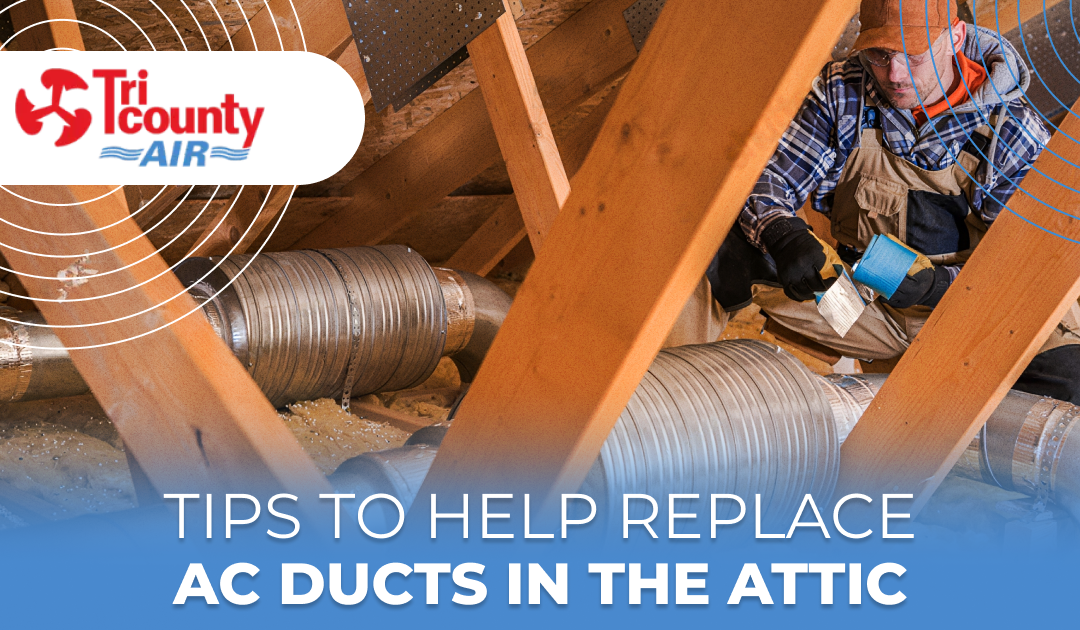Faulty or poorly installed attic ductwork can affect comfort, indoor air quality, and AC efficiency. Most homeowners are unaware of any issues with attic ducts. Regardless, replacing them can be a challenge. It can also lead to additional issues if not done correctly. Fortunately, Tri County Air can help with duct replacement and installing attic insulation.
Whether it’s time to replace AC ducts in the attic due to old ductwork, severely damaged ducts, indoor air quality issues, or unaffordable energy bills, here are some tips you should follow:
Make Sure Your Ducts Are Sized Properly
Undersized ducts can lead to balancing issues. Unbalanced ducts can lead to:
- High static pressure
- A noisy HVAC system
- Uneven airflow
By calculating the size of your ducts based on your AC system and the square footage of the conditioned space, you can have ductwork that allows air to flow evenly. Otherwise, some rooms will be cooler or warmer than others. High system pressure can also increase wear and lead to damage.
Add Support for Air Ducts
Unsupported flexible ducts can easily bend and kink, restricting airflow or causing tearing. But any air duct should be properly supported. Otherwise, balancing and airflow issues can occur. Proper anchoring prevents ducts from sagging and shifting. The best type of support depends on the material, configuration, and location of the ducts, so consult an HVAC professional to learn your options.
Protect Your Attic Ducts from Heat Transfer
Heat transfer can make your HVAC system inefficient. But it can be reduced to avoid cooling and heating issues throughout the year. Some of the solutions to consider when you replace AC ducts in the attic include:
- Moving the thermal boundary of your structure by insulating the roof with fiberglass, wool, rigid foam, or closed-cell polyurethane foam.
- Installing a reflective insulating material or radiant barrier on the roof to minimize heat buildup.
- Installing ducts closer to the floor to reduce contact between duct materials and heat. Cooler air tends to be near the attic floor (but ducts should hang instead of being in direct contact with the floor).
- Avoiding installing ductwork close to the roof deck, where heat transfer is greater.
- Designing and configuring ducts for more efficient air movement, which limits how much heat is added to the airflow.
Choose the Right Type of Ductwork
Hard ductwork is beneficial for its smooth interior, which improves airflow. It has a more durable shell and is insulated on the outside, preventing fibers from getting into the airflow. A more cost-effective option, flexible ducts are easier to fit in tight locations. Meanwhile, ribbed coils help keep them airtight.
Protect Your Ducts Against Moisture Buildup
Choose moisture-resistant insulating materials. Moisture can interfere with system performance, contribute to high indoor humidity, and allow mold to grow deep inside the ductwork. Burying ducts in the attic floor, and encapsulating them with insulation, is recommended in a hot, humid climate. Closed-cell polyurethane foam prevents humid air from contacting the duct’s outer layer. Avoid air-permeable materials such as loose-fill fiberglass or cellulose.
Call Tri County Air to Help Replace AC Ducts in the Attic
Replacing air ducts can be a challenging project. One mistake can have costly consequences. At Tri County Air, we specialize in AC duct installation and replacement. Our experienced technicians properly size, seal, and insulate ductwork. We can use spray foam to provide an air, vapor, and water barrier. We also provide blown-in cellulose insulation or a fiberglass material to increase moisture resistance. A radiant heat barrier coating can also be installed. For more information, call 941 485-2222.

